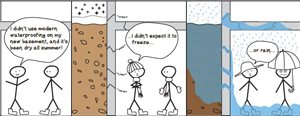The weather out here in Vancouver and the lower mainland is quite fantastic – I hiked in shorts and a t-shirt last weekend. Unfortunately, many places across the world are not experiencing such amazing luck, especially in Eastern Canadian & United States regions, where temperatures are dropping close to record lows.
These temperatures can have a negative effect on concrete.
The durability of concrete is defined by many different sources as the ability of concrete to resist wreathing, action, chemical attack, and abrasion while maintaining its desired engineering properties. As would be expected, concrete that faces different environmental actions must be designed to accommodate those without early deterioration.
Typical deterioration of concrete exposed to freeze-thaw conditions are:
- Random cracking;
- Spalling & surface scaling; and
- Joint deterioration due to D-cracking.
The deterioration of the concrete occurs because of the water freezing and subsequent expansion in the paste, aggregates, or both. The expansion pressure from the freezing water can exceed the tensile strength of the concrete, which is the causing the deterioration. This negatively affects the durability of concrete and threatens the lifespan of a structure. Thus, a mix-design appropriate for conditions that see freeze-thaw cycles must be done to ensure adequate durability.
To do so, an air entraining admixture (AEA) is important to add to the concrete. Air entrained bubbles are evenly and well dispersed through the concrete, and is highly resistant to this deterioration. Microscopic air bubbles in the paste provide chambers for the water to enter, which relive the hydraulic pressure generated.
When freezing occurs in concrete containing saturated aggregate, disruptive hydraulic pressures can also be generated within the aggregate. Water displaced from the aggregate particles during the formation of ice cannot escape fast enough to the surrounding paste to relieve pressure. However, under most exposure conditions, as paste of good quality (low water-cementing materials ratio) will prevent most aggregate particles from becoming saturated.
Further, if the paste is air-entrained, it will accommodate the small amounts of excess water that may be expelled from aggregates, thus protecting the concrete from freeze-thaw damage. This is why designing concrete specific to a certain region is of the utmost importance.
Here is an earlier blog with some recommendations for concreting in cold weather: https://www.kryton.com/2014/11/cold-weather-concreting/





